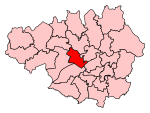Co-op Academy Swinton
1988 establishments in EnglandAcademies in SalfordEducational institutions established in 1988Secondary schools in SalfordSwinton, Greater Manchester ... and 1 more
Use British English from October 2010
The Co-op Academy Swinton is in Greater Manchester, England. Although named The Swinton High School in September 1988 when Wardley High School and Pendlebury High School merged, forming a single comprehensive school for pupils aged 11 to 16, on one site located half a mile from Swinton town centre. The Swinton High School joined the Co-op Academies Trust in March 2018 and is since known as 'Co-op Academy Swinton'.
Excerpt from the Wikipedia article Co-op Academy Swinton (License: CC BY-SA 3.0, Authors).Co-op Academy Swinton
Sefton Road, Salford Newtown
Geographical coordinates (GPS) Address Phone number Website Nearby Places Show on map
Geographical coordinates (GPS)
| Latitude | Longitude |
|---|---|
| N 53.5166 ° | E -2.3402 ° |
Address
Co-op Academy Swinton
Sefton Road
M27 6JU Salford, Newtown
England, United Kingdom
Open on Google Maps








